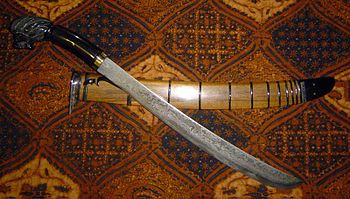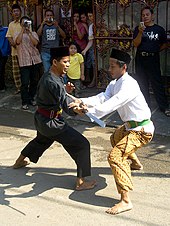
Silat Melayu, also known as Seni Persilatan Melayu or simply Silat, is a combative art of self-defence from the Malay world, that employs langkah ('steps') and jurus ('movements') to ward off or to strike assaults, either with or without weapons. Silat traced its origin to the early days of Malay civilisation, and has since developed into a fine tradition of physical and spiritual training that embodies aspects of traditional Malay attire, performing art and adat. The philosophical foundation of modern Malay Silat is largely based on the Islamic spirituality. Its moves and shapes are rooted from the basis of Silat movements called Bunga Silat, and Silat performances are normally accompanied with Malay drum assembles.

Pantun is a Malayic oral poetic form used to express intricate ideas and emotions. It generally consists of even-numbered lines and based on ABAB rhyming schemes. The shortest pantun consists of two lines better known as the pantun dua kerat in Malay, while the longest pantun, the pantun enam belas kerat have 16 lines. Pantun is a disjunctive form of poetry which always come in two parts, the first part being the prefatory statement called pembayang or sampiran that has no immediate logical or the narrative connection with the second or closing statement called maksud or isi. However, they are always connected by the rhymes and other verbal associations, such as puns and repeating sounds. There is also an oblique but necessary relationship and the first statement often turns out to be a metaphor for the second one. The most popular form of pantun is the quatrain, and the couplet (two-lines), which both featured prominently in the literature and modern popular culture.

The kris or keris is a Javanese asymmetrical dagger with a distinctive blade-patterning achieved through alternating laminations of iron and nickelous iron (pamor). The kris is famous for its distinctive wavy blade, although many have straight blades as well, and is one of the weapons commonly used in the pencak silat martial art native to Indonesia. Kris have been produced in many regions of Indonesia for centuries, but nowhere—although the island of Bali comes close—is the kris so embedded in a mutually-connected whole of ritual prescriptions and acts, ceremonies, mythical backgrounds and epic poetry as in Central Java. Within Indonesia the kris is commonly associated with Javanese culture, although other ethnicities in it and surrounding regions are familiar with the weapon as part of their cultures, such as the Balinese, Sundanese, Malay, Madurese, Banjar, Buginese, and Makassar people. The kris itself is considered as a cultural symbol of Indonesia and also neighbouring countries like Brunei, Malaysia, Philippines, Singapore, and Thailand.

Hang Tuah, according to the semi-historical Malay Annals, was a warrior and Laksamana who lived in Malacca during the reign of Sultan Mansur Shah in the 15th century. However, there is limited historical evidence for his existence. He was supposedly a great laksamana, or admiral, a diplomat and a silat master. Hang Tuah is the most illustrious warrior figure in Malay literature. He is however, a somewhat controversial figure and there is much in dispute about the factual basis of Hang Tuah's story.
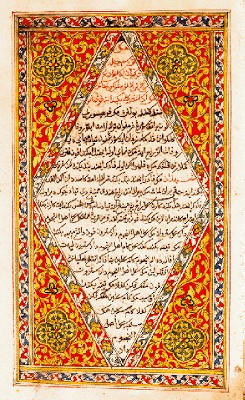
The Malay Annals, originally titled Sulalatus Salatin, is a literary work that gives a romanticised history of the origin, evolution and demise of the great Malay maritime empire, the Malacca Sultanate. The work, which was composed sometime between the 15th and 16th centuries, is considered one of the finest literary and historical works in the Malay language.

Pencak silat is an umbrella term for a class of related Indonesian martial arts. In neighbouring countries, the term usually refers to professional competitive silat. It is a full-body fighting form incorporating strikes, grappling, and throwing, in addition to weaponry. Every part of the body is used and subject to attack. Pencak silat was practiced not only for physical defense but also for psychological ends. There are hundreds of different pencak silat styles and schools which tend to focus either on strikes, joint manipulation, weaponry, or some combination thereof.

Hikayat Iskandar Zulkarnain is a Malay epic in the tradition of the Alexander Romance describing fictional exploits of Alexander the Great (Iskandar), identified with Dhu al-Qarnayn (Zulkarnain), a king briefly mentioned in the Quran. The oldest existing manuscript is dated 1713, but is in a poor state. Another manuscript was copied by Muhammad Cing Sa'idullah about 1830.

The Lantaka also known as rentaka was a type of bronze portable cannon or swivel gun, sometimes mounted on merchant vessels and warships in Maritime Southeast Asia. It was commonly equipped by native seafaring vessels from the Philippines, Indonesia, Brunei, and Malaysia. Lela and rentaka are known by the Malays as meriam kecil, the difference is that rentaka is smaller in length and bore than a lela. and Lantakas are often called Kanyon in Filipino.

Silat is the collective term for a class of indigenous martial arts from the Nusantara and surrounding geocultural areas of Southeast Asia. It is traditionally practised in Brunei, Indonesia, Malaysia, Singapore, Southern Thailand, Southern Philippines and Southern Vietnam. There are hundreds of different styles (aliran) and schools (perguruan) which tend to focus either on strikes, joint manipulation, weaponry, or some combination thereof.
Buyong Adil was a national historian of Malaysia and author of several books on the history of Malaysia. Buyong was a nickname given by his parents. He was also known as Cikgu Buyong. He would spend his later career working in the Dewan Bahasa dan Pustaka, a government regulating body that coordinates the use of the Malay language and Malay-language literature.

Kedahan Malays or commonly known as Orang Utara ('Northerners'), are a sub-group of Malays native to northern Malay Peninsula in areas of both current and historical area of Kedah. They are among the oldest ethnic groups in the Malay peninsula with a history dating back 2,800 years as proven by the discovery of sites in Bujang Valley and historical documents from India, China and Arabia. Kedahan Malays are one of the largest Malay sub-groups in Malaysia, comprising at least 15% of the total Malaysian Malay population including those with Kedahan ancestry.
Hikayat Amir Hamzah is a Malay literary work that chronicles the hero by the name Amir Hamzah. This book is one of the two Hikayat mentioned in Sejarah Melayu as one of the Hikayat used to encourage Malay warriors in their fight against invading Portuguese in Malacca in 1511.

Listed here are the weapons of pencak silat. The most common are the machete, staff, kris, sickle, spear, and kerambit. Because Southeast Asian society was traditionally based around agriculture, many of these weapons were originally farming tools.

Sembah is an Indonesian greeting and gesture of respect and reverence. While performing the sembah, one clasps their palms together solemnly in a prayer-like fashion called suhun or susuhun in Javanese; or menyusun jari sepuluh in Indonesian and Malay, placing them in front of their chest and moving the pressed palms up to their chin, or all the way up until their thumbs touch the tip of their nose, while bowing slightly. Any of these two forms are made depending on the status of the person greeted.
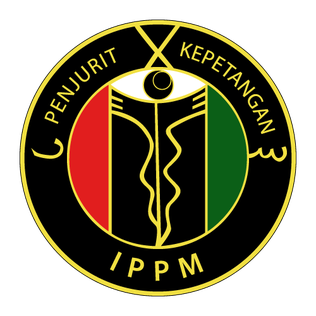
Istiadat Pewaris Penjurit-Kepetangan Melayu or formerly known as Ilmu Persilatan Penjurit-Kepetangan Melayu, shortform IPPM is one of the oldest original known to date Malay martial art form or called 'Silat' in existence which has been heritage from one generation to another. Descended from the first ruler of the Malayapura Kingdom, King Adityawarman whom is also known as Seri Maharaja Diraja which to a later stage sparked the start of Minangkabau history in Pagaruyung Kingdom, Sumatra, Indonesia. These story has been greatly narrated in most of old Malay Literature including in of the most reliable sources to date called Sulalatus al-Salatin or better known as The Malay Annals (Malay: Sejarah Melayu). The manuscript begin with the stories of Wan Malini and Wan Empuk whom was presented with 3 adopted princes right after when their rice fields was magically expelling gold. These 3 princes was later mark as the kickstart for the next 3 big empires in Malay Archipelago. Those empires were the Kingdom of Majapahit, The Malacca Sultanate and the Pagaruyung Kingdom around the 12th century.
Hulubalang were the military nobility of the classical Malay kingdoms in Southeast Asia. In western sources, "Hulubalang" is roughly translated as "warlord", "commander", "general" or simply "warrior". An early literary reference to the word Hulubalang appears in the Malay Annals. It is mentioned in the text that among four senior nobles of Kingdom of Singapura (1299–1398), there was a position called Hulubalang Besar, first held by Tun Tempurung, that equivalent to chief of staff of the army, who commands several other Hulubalangs. The legendary strongman of Singapura, Badang, was among the notable Hulubalang of the kingdom, promoted to the rank during the reign of Sri Rana Wikrama.

Pelang or pilang is a traditional boat from Indonesia and Malaysia. It may refer to several different types of boats in the Nusantara, but commonly they refer to an outrigger canoe. The function differs from where they were used, from transporting people, fishing, to trading. Pilang has been known from at least the 14th century.
Cerucuh is an ancient, small Malay trading boat. One of the earliest record of cerucuh has a background of 14th century, being mentioned in Malay Annals which was composed no earlier than 17th century, being used by Majapahit empire during the first Majapahit attack on Singapura (1350). Malay Annals recorded:
Maka betara Majapahitpun menitahkan hulubalangnya berlengkap perahu akan menyerang Singapura itu, seratus buah jung; lain dari itu beberapa melangbing dan kelulus, jongkong, cerucuh, tongkang, tiada terhisabkan lagi banyaknya.
So the king of Majapahit ordered his war commander to equip vessels for attacking Singapore, a hundred jong; other than that a few melangbing and kelulus; jongkong, cerucuh, tongkang, all in uncountable numbers.
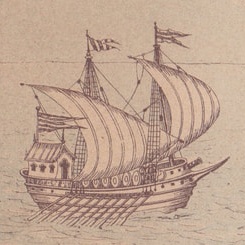
Mendam Berahi was a legendary royal galley said to have been used by the Malacca Sultanate in the early 16th century. This ship is fictional, recorded in the epic Hikayat Hang Tuah, and that type of ship, the ghali, did not exist until after the 1530s.
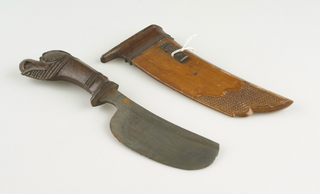
The Bendo is a traditional bladed tool from Java, Indonesia. Betawi people would regard the Bendo as a domestic household tool and sometimes it is also called golok dapur, which means a "kitchen golok".
